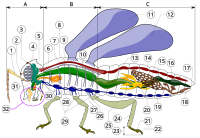
Photo from wikipedia
Simple Summary To better understand how thrips detect and receive semiochemicals for intra- and interspecific communication, host selection, and mating, scanning electron microscopy was used to examine and compare the… Click to show full abstract
Simple Summary To better understand how thrips detect and receive semiochemicals for intra- and interspecific communication, host selection, and mating, scanning electron microscopy was used to examine and compare the external morphology, distribution, and ultrastructure of the antennal sensilla in three alfalfa-feeding thrip species, Odontothrips loti, Megalurothrips distalis, and Sericothrips kaszabi. Nine major types of antennal sensilla were identified with similar morphology and distribution pattern among these thrip species. However, differences in the length and number of antennal sensilla were also found between male and female individuals and between species. Therefore, this study expands the understanding on the morphology of antennal sensilla in Thysanoptera (especially the suborder Terebrantia) and lays a morphological foundation for exploring the olfactory mechanism in thrips. Abstract Thrips are important pests to alfalfa Medicago sativa. Similar as many other plant-feeding insects, thrips rely on the antennae to receive chemical signals in the environment to locate their hosts. Previous studies indicated that sensilla of different shapes on the surface of insect antenna play an important role in signal recognition. However, morphological analysis of the antennal sensilla in Thysanoptera has been limited to only a few species. To expand the understanding of how antennal sensilla are related to semiochemical detection in thrips, here we compared the morphology and distribution of antennal sensilla in three thrip species, Odontothrips loti, Megalurothrips distalis, and Sericothrips kaszabi, by scanning electron microscope (SEM). The antennae of these three species are all composed of eight segments and share similar types of sensilla which distribute similarly in each segment, despite that their numbers show sexual dimorphism. Specifically, nine major types of sensilla in total were found, including three types of sensilla basiconica (SBI, SBII, and SBIII), two types of sensilla chaetica (SChI and SChII), and one type for each of sensilla coeloconica (SCo), sensilla trichodea (ST), sensilla campaniformia (SCa), and sensilla cavity (SCav). The potential functions of sensilla were discussed according to the previous research results and will lay a morphological foundation for the study of the olfactory mechanism of three species of thrips.
Journal Title: Insects
Year Published: 2021
Link to full text (if available)
Share on Social Media: Sign Up to like & get
recommendations!